Our Favorite Hotels in Nara
• Luxury: Fufu
• Ryokan: Kotonoyado Musashino
• Cheap Hotel: Guest House Oku
• Near Kintetsu-Nara Station: Noborioji
• For Couples: Hotobil An inn
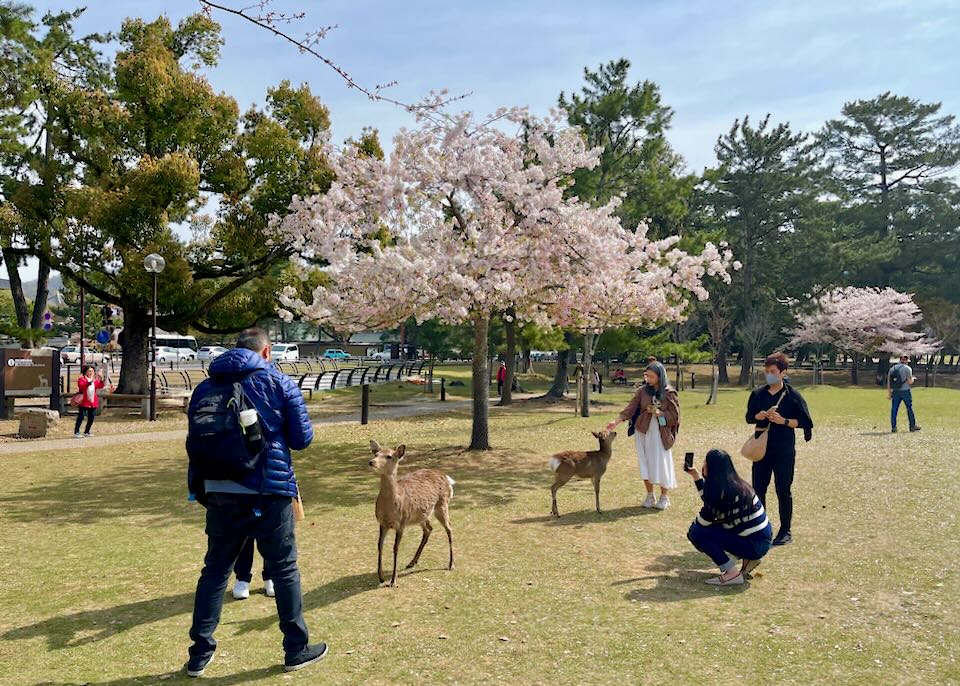
People feed Sika deer in Nara Park.
The Best Areas to Stay in Nara
Nara became Japan’s first permanent capital in 710 AD – 84 years before Kyoto – and is still regarded as the birthplace of Japanese culture. It remains a relatively small city, some 25 miles (40km) south of Kyoto and just 20 miles (30km) east of Osaka, at the heart of Japan’s central Kansai region. Like Kyoto, Nara was one of the few Japanese cities spared from destruction in WWII, and today, its spectacular temples, traditional streets, museums, art galleries, and deer-filled parks make it one of Japan’s most enticing destinations. Tourism has blossomed here in recent decades, with lots to see, an efficient transport system, and plenty of English signage (and speakers), making it a popular day trip from Kyoto. However, you’ll get more out of it by staying a few nights. The city has an excellent spread of hotels, usually offering cheaper rates than its neighboring cities.
Nara Neighborhoods
Nara Hotel sits on the edge of Nara Park and Ara Pond.
There are three key areas of interest in Nara: Nara Park, Nara Station and Downtown, and Naramachi—and a fourth, Nishinokyō, just to the west of the city center.
Most of the main sights are on the city’s eastern side in the gardens, hills, and green woodlands of Nara Park. This is where Nara’s photogenic deer hang out. Other sites include the giant bronze Buddha of Tōdai-ji, Kasuga Grand Shrine (Nara’s holiest Shinto shrine), and Nara National Museum.
Nara Station and Downtown lie on the west side of the city center, connected to Nara Park by the mostly pedestrianized Sanjō-dōri. There’s not much to see, but plenty of restaurants, bars, and hotels, and it’s convenient for those traveling by train.
Kamado restaurant and market is in a restored machiya house in Naramachi, Nara.
To the south lies the beautifully preserved traditional merchant’s quarter of Naramachi, where charming dark wood “machiya” shophouses serve as galleries and craft shops. It’s the most atmospheric part of the city.
Western Nara beyond the station is known as Nishinokyō. It’s primarily residential but has several key historic attractions – Nara Palace Historical Park, Toshodai-ji, and Yakushiji Temple but few places to stay.
Getting Around Nara
While it’s relatively easy to explore the city center on foot, you’ll need to use public transportation to get across the city or reach sights on the outskirts. Buses zip between JR Nara Station (and the Kintetsu-Nara Station) to the Nara Park temples and museums – the standard fare is ¥220 within the city center (one-day passes are ¥500). The private Kintetsu Railway (separate from the JR network) also runs to stations near Yakushiji Temple and the Nara Palace Site Museum.
The Best Places to Stay in Nara
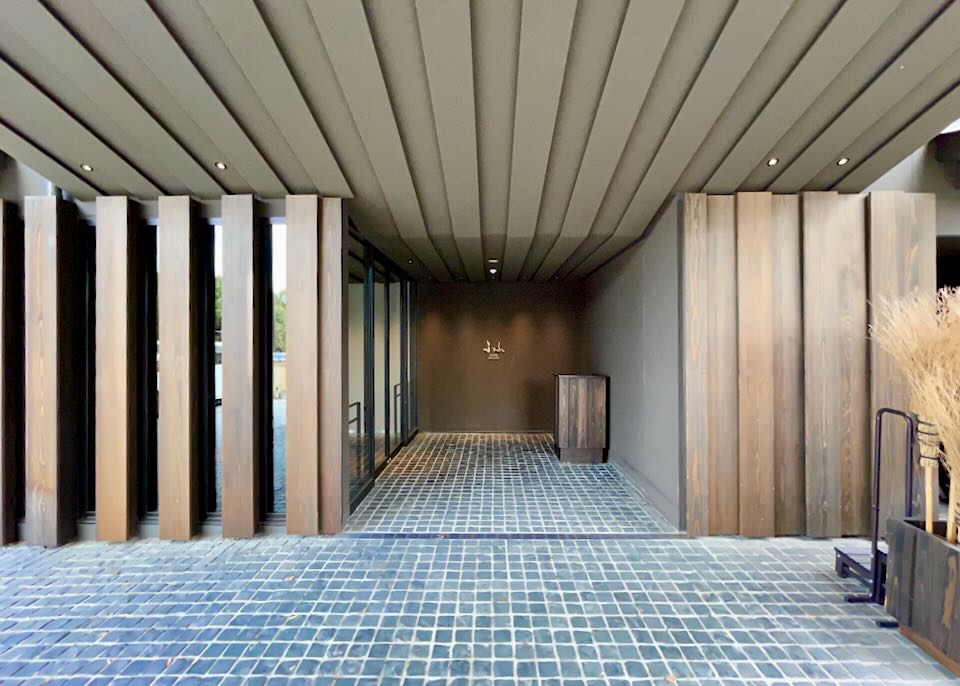
The entrance to the luxurious Fufu hotels in Nara Park.
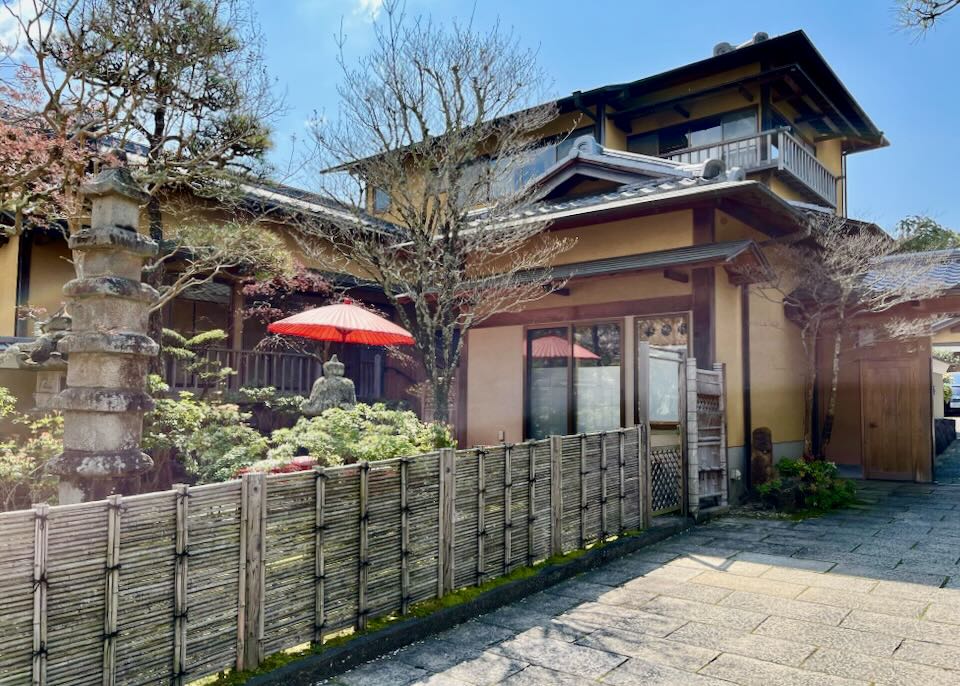
The Kotonoyado Musashino Ryokan.
- Best Luxury Hotel in Nara
Fufu- Best Ryokans in Nara
Kotonoyado Musashino • Hotobil An inn • Shikitei • Edosan- Best Cheap Hotels in Nara
Guest House Oku • Guesthouse Naramachi • Visitor Center and Inn • Slow House • Iroha Grand Hotel Kintetsu- Best Hostels in Nara
Guesthouse Nara Backpackers • Hilo HostelBest Places in Nara for…
- Best Neighborhood in Nara to Stay for Sightseeing: Nara Park
The giant bronze Buddha “Daibutsu” in Tōdai-ji temple
Staying in one of the hotels in or around Nara Park (Nara-kōen), on the eastern side of the city center, means you’ll be within walking distance of Nara’s major attractions and sights: Tōdai-ji and the giant Buddha statue (Daibutsu), the Kasuga Grand Shrine, the priceless art collections at Nara National Museum, Kōfuku-ji temple, with its iconic five-storied pagoda, the traditional Japanese gardens of Yoshikien and Isui-en, and the Ukimido, a beautiful pavilion in the center of Sagiike Pond. You’ll also be able to access the park and admire its famous sika deer before and after the daytrippers. The Kintetsu-Nara Station is relatively convenient for Nara Park, but the JR Nara Station is a bus or taxi ride away.
- Most Romantic Neighborhood: Naramachi
Nara is a romantic city, and staying overnight means you’ll be able to enjoy the historic streets, temples, and parks in the early mornings and evenings when most tourists have left the city. Sunsets viewed from Tōdai-ji Nigatsu-dō (February Hall) in Nara Park are especially magical. Every night the week before Valentine’s Day, the Nara Rurie festival sees the Nara National Museum, Tōdai-ji, and Kasuga Grand Shrine lit up by hundreds of lanterns from 6 pm to 9 pm. Overall, though, the most romantic neighborhood is Naramachi. You can stay at traditional ryokans (like Hotobil and Ryokan Matsumae) and beautiful small hotels, exploring narrow streets lined with traditional Japanese houses, arts and crafts shops, intimate dining spaces, and candle-lit bars – Lamp Bar is an atmospheric spot for a cocktail.- Best Neighborhood for Nightlife: Naramachi
Nara is a small city and isn’t known for nightlife, though you’ll find neighborhood izakayas (Japanese-style bars) scattered all over the center. We like the bars in Naramachi best – it’s the city’s most atmospheric neighborhood, and most bars and restaurants occupy traditional wooden Japanese buildings with small courtyards and gardens off narrow, winding alleys. Good choices include the Salon des Vins Seve wine bar and cocktails at Lamp Bar (which famously has no menu – the mixologists make whatever you like). Bar Fiddich (above a Korean restaurant) is good for Japanese craft beers, while Bar Garage and R-bar are relatively cheap and offer karaoke.
- Best Neighborhood for Food and Restaurants: Naramachi
Nara’s famous “persimmon leaf sushi” at Izasa Restaurant Sanjō.
Naramachi, along with Sanjō-dōri in Downtown Nara, is also the best place to eat in Nara. There’s not a lot of choice in or around Nara Park, and though there are plenty of cheap places in and around Nara Station, the best restaurants tend to be located in Naramachi (though the city’s top restaurant, Wa Yamamura, is further west near Shin-Ōmiya Station). At the high end, Kappo Matsuki and Okada are two of Nara’s best kaiseki restaurants (traditional, multi-course meal), while Nakamura is one of the better izakayas (casual, small plates). Throughout the neighborhood, you’ll find various restaurants and bars serving some of Nara’s beloved specialties, like persimmon leaf sushi (with its subtle fermented taste), at spots like Izasa Restaurant Sanjō Branch. Other Nara specialties include narazuke pickles, miwa somen (thin, chewy noodles), persimmon sweets and cakes, kakigori (Japanese shaved ice), and a bewildering number of sweet treats. You’ll also see almost every specialty sold at the food court above Nara Station.
- Best Neighborhoods for Shopping: Downtown and Naramachi
The covered Higashimuki Shopping Street.
You’ll find excellent shopping in the central Downtown area. Higashimuki Shopping Street is the premier covered shopping strip, and Sanjō-dōri, the main drag between Nara Station and Nara Park, is lined with souvenir stalls. On the south side of Sanjō-dōri, the covered Mochiidono Shopping Arcade leads into Naramachi, where you’ll find a range of independent craft shops and small galleries. Yu Nakagawa (300 years old!) offers traditional Nara crafts, from fabrics to wooden carvings. Nippon Ichi sells dried fruits and pickles, deer-themed gifts, and items made from traditionally made local cloth. Ishii on Sanjō-dōri is the place to stock up on Nara’s celebrated persimmon products (from dried fruits to jams/jellies). Also on Sanjō-dōri is Tabi-ji (for contemporary Japanese-style footwear), Ikeda Gankōdō (for traditional fans), and Issindo for calligraphy brushes and ink.
- Best Neighborhood to get off the Beaten Path: Asuka
Some 50 minutes south of Kintetsu-Nara Station by train, Asuka is a sleepy village of traditional homes and rice paddies rich in history – and very few tourists. Though little has survived today, this was the home of the first emperor. Learn about the remaining ruins at the Asuka Historical Museum or the National Asuka History Park Museum, which also preserves some of the many ancient tumuli in this area (tombs). Asukadera Temple was Japan’s first major Buddhist place of worship in the 6th century, with its 7th-century bronze Great Buddha, Japan’s oldest Buddha statue. Nearby, Okadera Temple offers beautiful views and vivid fall colors. It’s a short ride to Kashihara Shrine, built in the 1890s to honor Emperor Jimmu, said to have become Japan’s first emperor here in 660 BC (the Mausoleum of Emperor Jimmu is also nearby). To the north lies the attractive neighborhood of Imaicho, known for its wonderfully preserved Edo-era streets and houses. The exclusive Shinrajuku ryokan and the modern The Kashihara hotel are good places to stay around Asuka.
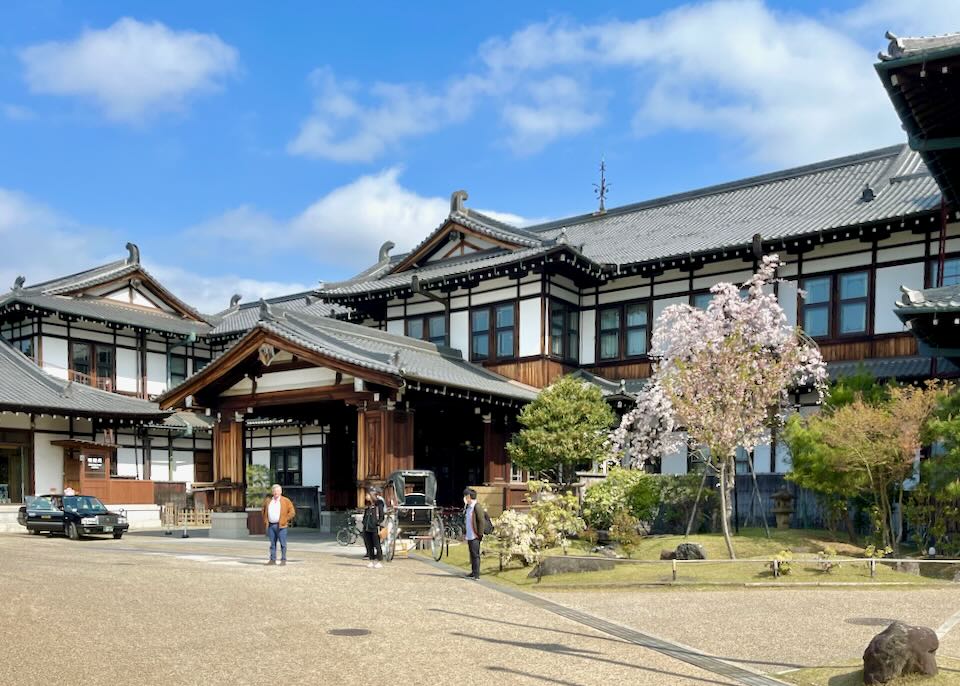
The exterior of the Nara Hotel.
The 4 Best Areas in Nara for Tourists
1. Nara Park
Tōdai-ji temple.
The vast, forested parklands on the east side of Nara are known as Nara Park (Nara-kōen) and encompass some of the city’s (and the nation’s) most precious historical and religious sites and sacred Mount Wakakusa. Though you’ll likely be spending much of your time here, there are only a handful of hotels and few places to eat or drink. But it does have deer.
Resting deer in Nara Park.
Nara’s beloved symbol is regarded as a sacred animal in the Shinto religion. Around 1,500 sika deer live here, and you’ll see them wandering all over the place. Protected and comfortable around the crowds of people feeding them special “deer crackers” (shika sembei, sold by vendors all over the park), they may seem tame (some of them even seem to “bow” to get crackers). Still, they are wild, free to forage up the slopes of Mount Wakakusa and beyond.
For many tourists, feeding the deer is the highlight of a trip to Nara, but you’ll also find large crowds heading to Tōdai-ji, Nara’s premier attraction. One of Nara’s “Seven Great Temples” was completed in 752 AD, and Emperor Shōmu unveiled its giant bronze Buddha (Daibutsu). The 50ft (15m) high statue holds court in the gargantuan Kondō (or Great Buddha Hall). Arrive when they open, at 7.30 am, if you want to see it without hordes of people.
Further up the slopes of Wakakusa, the Tōdai-ji Nigatsu-dō (February Hall) and 8th-century Tōdai-ji Hokke-dō (Sangatsu-dō, Nara’s oldest building) are equally impressive temple buildings. There are fabulous views across the city and usually far fewer people.
Shrimp tempura and fried chicken udon at Mizuya Chaya, traditional teahouse and café.
You can walk across Nara Park from here, grabbing noodles for lunch at rustic Mizuya Chaya restaurant before strolling up to the Kasuga Grand Shrine, a striking Shinto temple that’s another major Nara attraction. It’s worth paying to get inside the inner courtyards, lined with some 3,000 bronze lanterns. Kasuga is also famous for the two thousand stone lanterns that line its main approach and the wisteria trees (“sunazuri-no-fuji”) that bloom in late spring. Trails lead further into the atmospheric Mout Kasuga Primeval Forest from here, often utterly devoid of people.
Some of the bronze lanterns that line the courtyards at Kasuga Grand Shrine.
There’s much more to see back down at the park’s western edge. The Nara National Museum has priceless collections of ancient Japanese paintings, sculptures, ritual bronzes, and other religious artifacts. Kōfuku-ji temple, with its iconic five-storied pagoda (the second-tallest wooden pagoda in Japan), has beautiful Buddhist statues (in the Tōkondō and Kokuhōkan halls). The lovely and free Yoshikien Garden, laid out in 1919, is next to the much older Isui-en Garden and the Neiraku Museum of Art (known for its traditional Japanese ceramics). And the Ukimido, a traditional wooden pavilion in the center of Sagiike Pond, is especially beautiful during cherry blossom season.
Ukimido (pavilion) at Sagiike Pond
Staying here means you’ll get a head start visiting Nara’s premier sights. It also tends to be much quieter at night. You’ll usually have to take a taxi or public transport to shops, restaurants, and bars (and Nara Station).
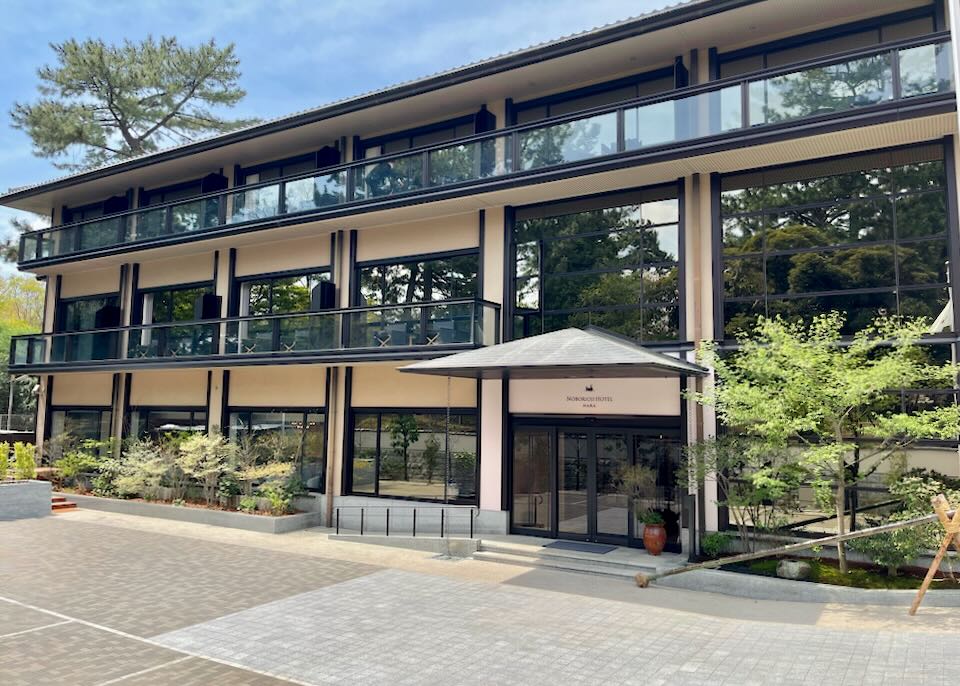
The Noborioji Hotel.
- The Best Hotels in and around Nara Park:
Fufu Hotel phone: +81 57 001 1722
Noborioji Hotel phone: +81 12 099 5546
Kasuga Hotel phone: +81 74 222 4031
Nara Hotel Hotel phone: +81 74 226 3300- Best Ryokans:
Kotonoyado Musashino Hotel phone: +81 74 222 2739
Shikitei Hotel phone: +81 74 222 5531
Edosan Hotel phone: +81 74 226 2662- Best Cheap/Midrange Hotels:
Iroha Grand Hotel Kintetsu Hotel phone: +81 74 227 0168
Deer Park Inn Hotel phone: +81 74 281 7222- Best Hostel:
Guesthouse Nara Backpackers Hotel phone: +81 74 222 45572. Nara Station & Downtown
By the JR Nara Train Station is the DMG Mori Nara Product Development Center that creates metal processing technology.
Nara Station, operated by Japan Railways, lies on the western side of the city center. It’s part of a busy commercial district but it’s quicker to take the bus as it’s a mile-long walk from the edge of Nara Park and most of the city’s attractions. It’s a convenient place to stay if traveling by JR train (you can walk to your accommodation), and there’s a choice of good value, modern accommodations here, and plenty of cheap places to eat and drink.
The Nara Craft Market
Nara Craft Market, held outside the station on Sundays, is great for souvenirs and gifts. Inside the station, the 2nd floor has an excellent gift and food section, with shops selling all the local specialties (from persimmon sweets to Mahoroba Daibutsu Pudding – flavored egg custard in jars).
Mahoroba Daibutsu Puddings, some spiked with local sake, sold at Nara Station.
From the station, you can walk through the city center on the mostly pedestrian Sanjō-dōri, the main street lined with shops, cake and sweet sellers (like Nakatanidou), and restaurants. You’ll also find the famous “Nara” sign along here. Just before you reach Sarusawa-ike Pond and the edge of Nara Park, Sanjō-dōri cuts across Higashimuki Shopping Street to the north. The city’s premier covered shopping strip. On the other side of Sanjō-dōri, the covered Mochiidono Shopping Arcade leads south into the Naramachi district, lined with craft shops and small restaurants.
A food stall along Higashimuki Shopping Street.
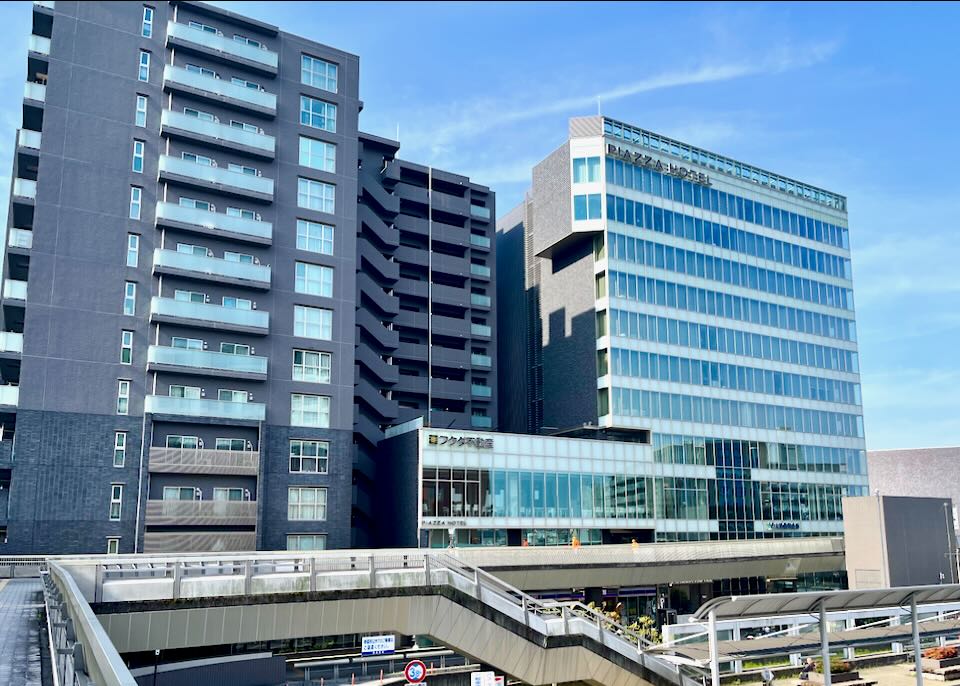
Piazza Hotel is a few minutes walk from JR Nara Station.
- The Best Hotels around Nara Station & Downtown:
Piazza Hotel phone: +81 74 230 2200
Super Hotel Lohas JR Nara Eki Hotel phone: +81 74 227 9000- Best Cheap Hotels:
Guest House Oku Hotel phone: +81 74 287 1574
Guesthouse Komachi Hotel phone: +81 74 287 0556- Best Hostel:
Hilo Hostel Hotel phone: +81 74 293 41323. Naramachi
Sarusawa-ike Pond.
The southern section of central Nara, below Sanjō-dōri and Nara Park, is the historic Naramachi neighborhood. It’s the most atmospheric part of the city. A grid of mostly narrow streets lined with traditional Japanese homes and wooden structures, many converted into dessert and craft shops, cafés, art galleries, boutique hotels, and ryokans.
Many of these “machiya” style townhouses date back to the 1700s, once the home of merchants and tradesmen. You can look inside one of them for free at the Naramachi Lattice House (Kōshinoie), an artful reproduction with tiny tatami rooms and an inner garden. Wandering the back streets is the best way to soak up Naramachi’s charms. Many locals still live here. You can also visit Gango-ji Temple, an ancient Buddhist shrine established here in 718 AD, and still proud of its rare, 6th-century tiles (there are always far fewer tourists here than Tōdai-ji).
Grave markers at Gango-ji Temple.
Other highlights include the Nara-machi Shiryōkan museum, with its small collection of Nara crafts and folk art, and the tempting array of shops and Nara confectionary specialists on Shimomikado Street (at the southern end of covered Mochiidono Shopping Arcade). Nakanishi Yosaburo is one of the oldest sweet shops, famed for its inventive “wagashi” (Japanese cakes and sweets used in tea ceremonies). Try them at the on-site tearoom. Fans of Japanese sake should visit the Harushika Sake Brewery, where you can tour a traditional sake maker and taste several varieties (around 5 for ¥500).
Near Sarusawa-ike Pond, you’ll find delicate arts and crafts at Nakagawa Masashichi Shoten (aka Yu Nakagawa), one of Nara’s oldest craft stores. Fans of Japanese history should check out the 8th-century Shin-Yakushi-ji, a Buddhist temple a mile or so further east (not far south from the Kasuga Shrine in Nara Park), best known for its ancient statues. In the main hall stands a giant “Medicine Buddha” carved from a single block of Japanese kaya wood (aka Japanese nutmeg-yew), surrounded by 12 stunning ceramic statues of the “Twelve Heavenly Generals,” protective deities (sadly, no photos allowed.)
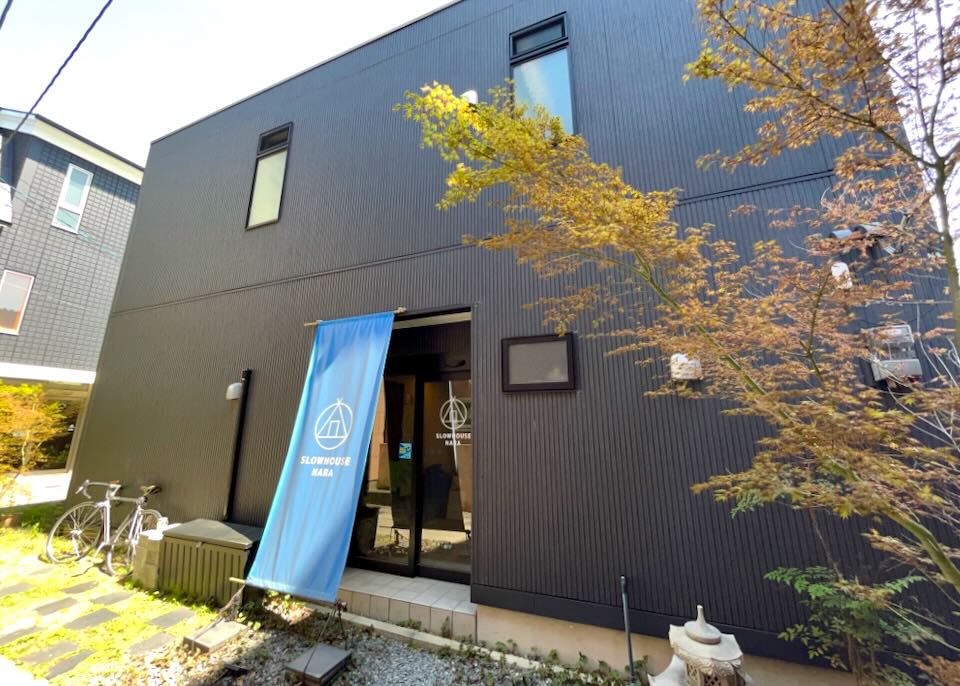
Slow House guest house.
- The Best Hotel in Naramachi:
Slow House Hotel phone: +81 74 242 9603- Best Ryokans:
Hotobil An inn Hotel phone: +81 74 237 3278
Matsumae Hotel phone: +81 74 222 3686- Best Cheap Hotels:
Guesthouse Naramachi Hotel phone: +81 74 287 0522
Any B&B+Coffee
Visitor Center and Inn Hotel phone: +81 74 281 8585
Guesthouse Kamunabi Hotel phone: +81 74 277 2765- Best Hostel:
Deer Hostel4. Nishinokyō (West Nara)
The former Imperial Audience Hall (Daigokuden) at Nara Palace Historical Park.
The Nishinokyō area of West Nara, about 2 miles (3.5km) from Nara Station, is primarily an affluent residential district but retains much of its historic ambiance and several key sights. Though popular with locals and Japanese tourists, especially on weekends, during the week, you’ll have many sites to yourself.
Not far from Yamato-Saidaiji Station is the newly developed Nara Palace Historical Park. It was the location of the Emperor’s home, Heijō Palace, in the 8th century and the hub of the Japanese government in the Nara period. The original city of Nara, Heijō-kyu, was established here, west of the current center. The site has been excavated and preserved since the 1970s. In recent years, cypress wood reproductions were added: the massive Former Imperial Audience Hall (Daigokuden), Nammon (South Gate), and Suzakumon, with more being constructed. For context, visit the Nara Palace Site Museum or the newer Heijokyu Izanai-kan (Guidance Center.) They offer family-friendly interactive exhibits and a replica of the “Kentoshi Ship” (which carried an official mission to Tang Dynasty China). Everything is free and labeled in English.
The moss garden at Toshodai-ji temple.
From here, walk south along the Akishino River (lined with cherry blossoms in spring) to the temple district. Toshodai-ji is a beautiful 8th-century Buddhist temple founded by revered Chinese priest Ganjin Wajo (aka Jianzhen). It’s best known for its ancient Golden Hall and lush moss gardens. A bit further south (near Nishinokyō Station) is Yakushiji Temple. It’s another of the Seven Great Temples of Nara and features two enchanting pagodas – the 112-foot East Pagoda was completed in 730 AD.
Further west, near Kaerumata Pond (and Ayameike Station), lies the sleek Modernist Museum Yamato Bunkakan. It contains ancient art from all over East Asia, and the smaller Nakano Museum of Art displays mainly modern paintings.
- There are not many hotels here, most inconvenient for public transportation. You’re better off staying in the city center and taking day trips by train.
Nara With More Time
We’ve covered our favorite neighborhoods to visit in more detail above, but with more time, there is plenty to see to the south in the Kii Peninsula. Highlights include the ancient burial mounds and ruins around Asuka (also home to the Kashihara Shrine dedicated to Japan’s first Emperor), Mount Yoshino, with its cherry blossoms and spectacular mountain temples and shrines, and the historic hot spring town of Dorogawa near the sacred Buddhist mountain of Mount Ōmine.
Nara Travel Tips
- Though most hotels, some shops, and restaurants will have English speakers on hand, don’t assume everyone will understand you. The staff at the main JR Ticket Office at Nara Station can communicate in English, menus usually have photos you can point at, and signage in the station (and around the city) is translated into English, but try to learn a few words and numbers in Japanese if you can.
- Renting a car can be a hassle in Japan because you need an International Driver’s License, and not all road signs are in English. If you intend to stay in central Nara, renting a car is unnecessary. Assuming you can get an international license, it can be helpful to have your own transport to explore the rural areas beyond the city: the historic sites around ancient Asuka, the shrines of Mount Yoshino and Yoshino Kumano National Park, and off-the-beaten path destinations on the Kii Peninsula to the south.
- The closest major airport to Nara is Kansai International Airport, some 46 miles (75km) southwest. Direct buses run to Kintetsu-Nara Station in around 1hr 25min, while trains run to JR’s Nara Station in about 1hr 30min (with a change at Osaka’s Tennoji Station). Kintetsu-Nara Station is more centrally located than the JR station, within walking distance of Nara Park, and also offers faster train services to Osaka and Kyoto (both in around 35 minutes). You’ll need to take a taxi or a bus to Nara Park if arriving at JR’s Nara Station (40 minutes from Kyoto and 50 minutes from Osaka Station). Osaka International Airport lies 28 miles (45km) to the northwest but only handles domestic flights, and getting to Nara will take at least 2 hours by train (with one or two changes in Osaka).
- If traveling by bullet train (Shinkansen), you must change to regular train services at Kyoto or Osaka station for the final leg to Nara.
- Getting around Nara by bike is becoming more popular – the city center is relatively flat, though things get much hillier as you head east into Nara Park. Nara Rent-a-Cycle near Kintetsu-Nara Station is a good central option, though many hotels in Nara also rent bicycles.
- Free Wi-Fi is available at hotspots throughout the city thanks to “NARA_Free_Wi-Fi”. Much of the city center (including the two stations) and Nara Park is covered.
- Nara Visitor Center & Inn (the main visitor information center) is at the western end of Nara Park at Sarusawa-Ike Pond, with multilingual staff, free Wi-Fi, ATM, and money exchange (open daily 8 am–9 pm).
- Nara is especially busy in spring and autumn when much of Nara Park (and Tōdai-ji, home of the giant Buddha) is busy with tour groups. Avoid Nara on Sundays year-round and during Japanese public holidays, when the city – especially around Nara Park – can become jam-packed with day-trippers.
Read More
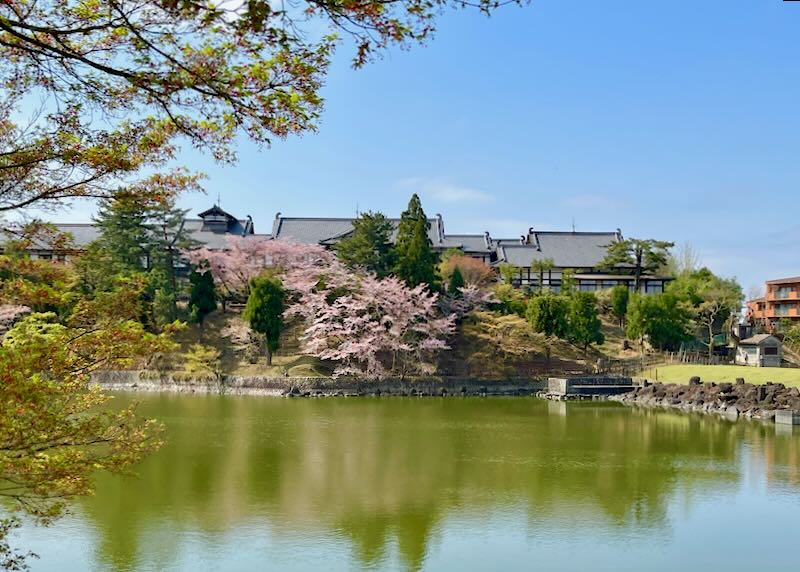
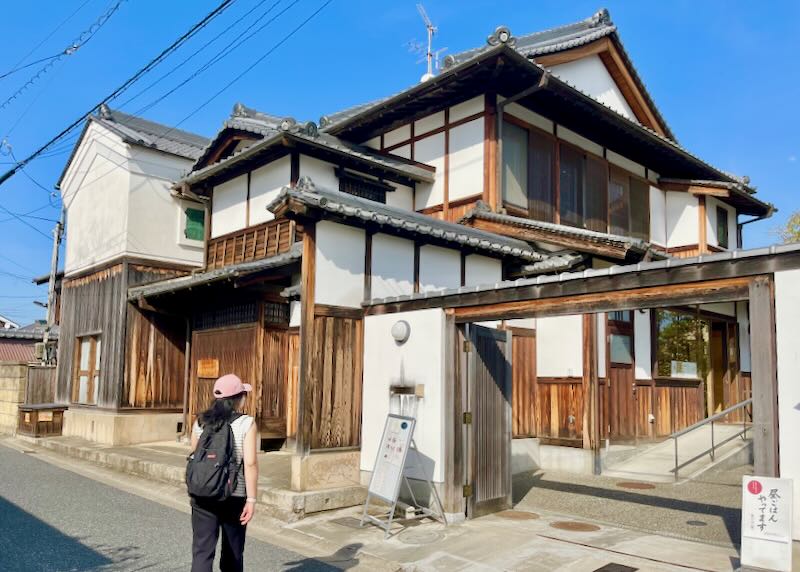
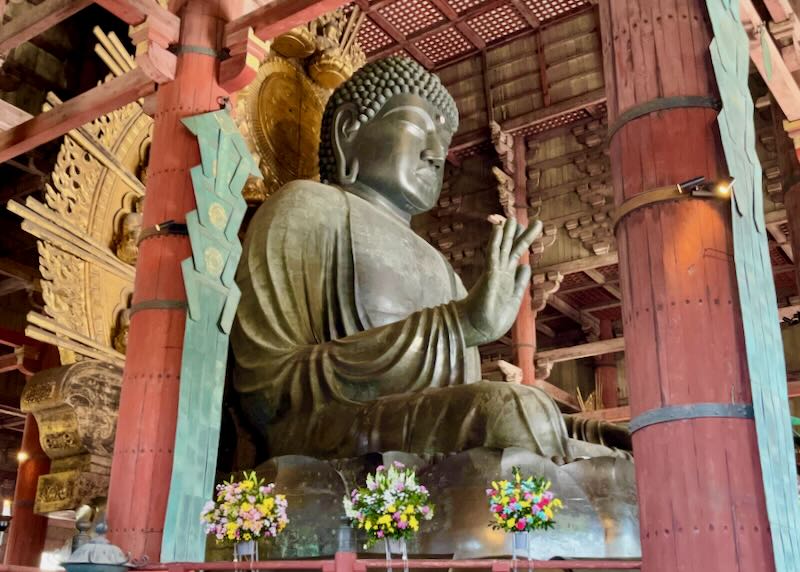
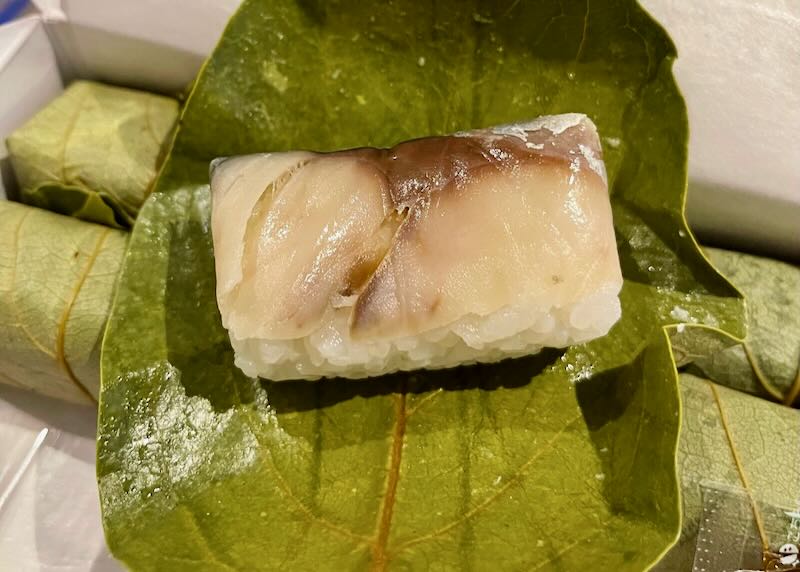
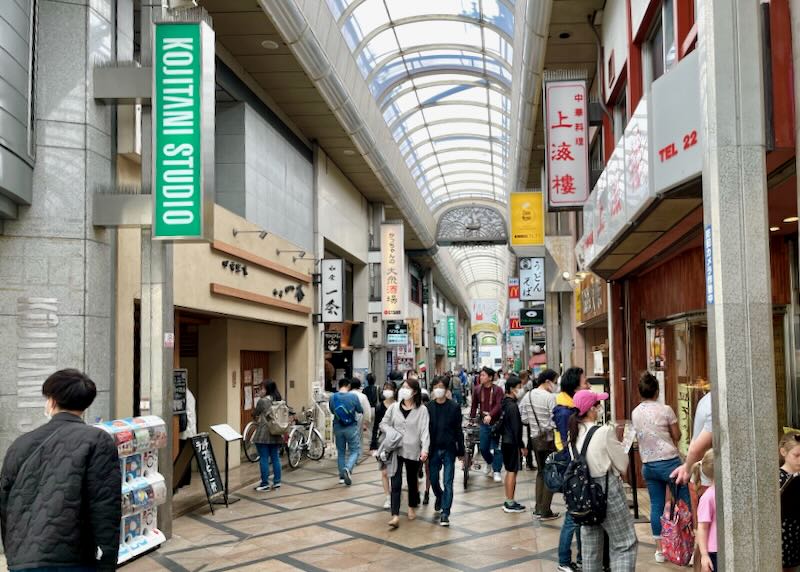
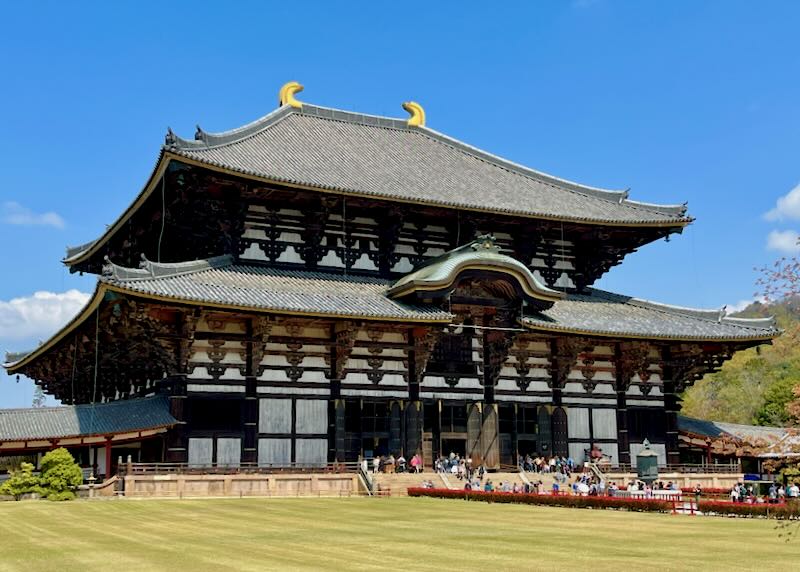
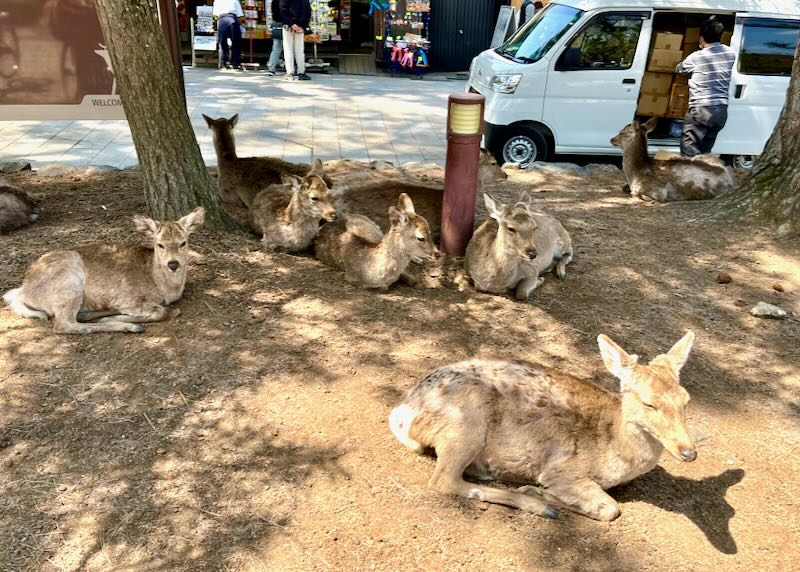
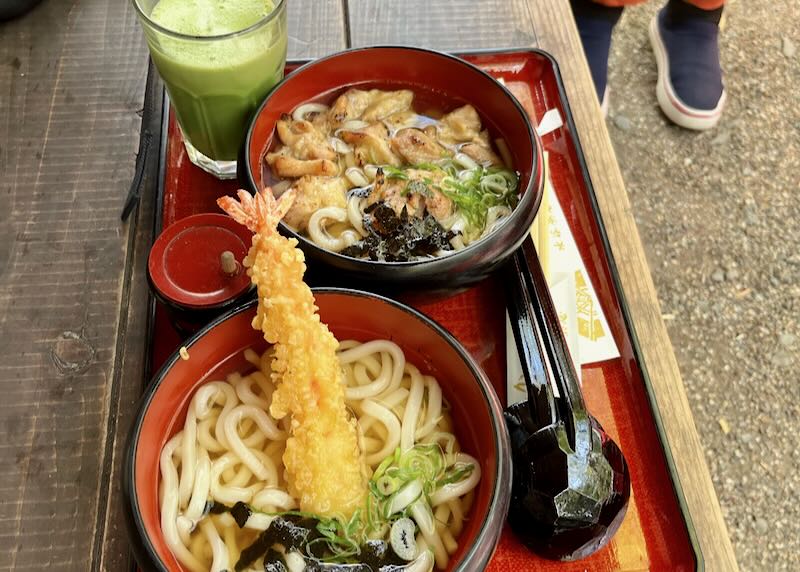
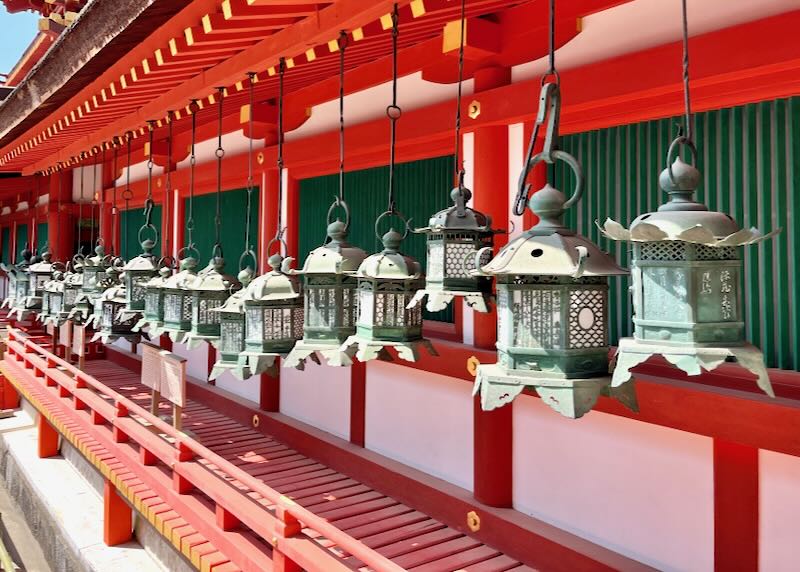
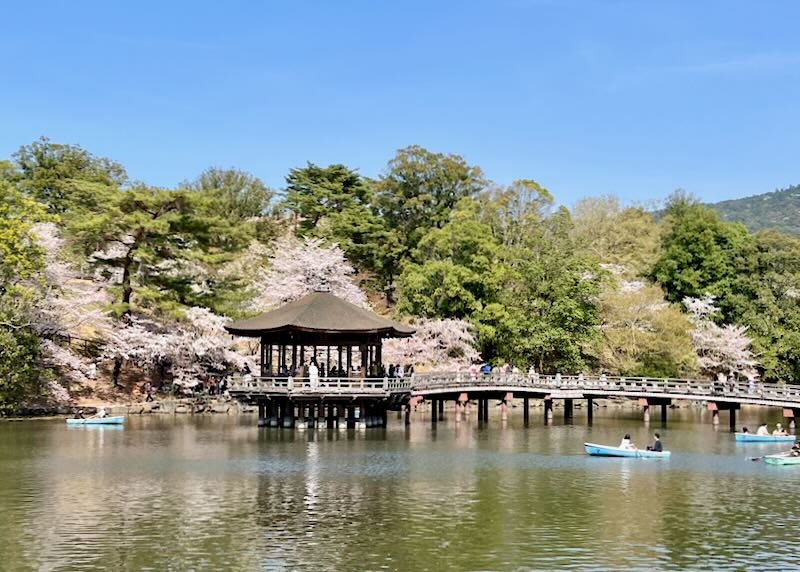
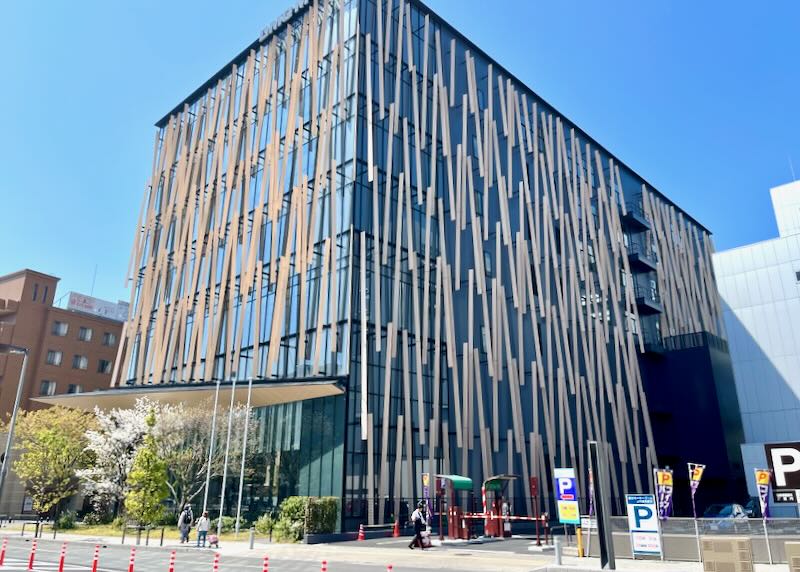
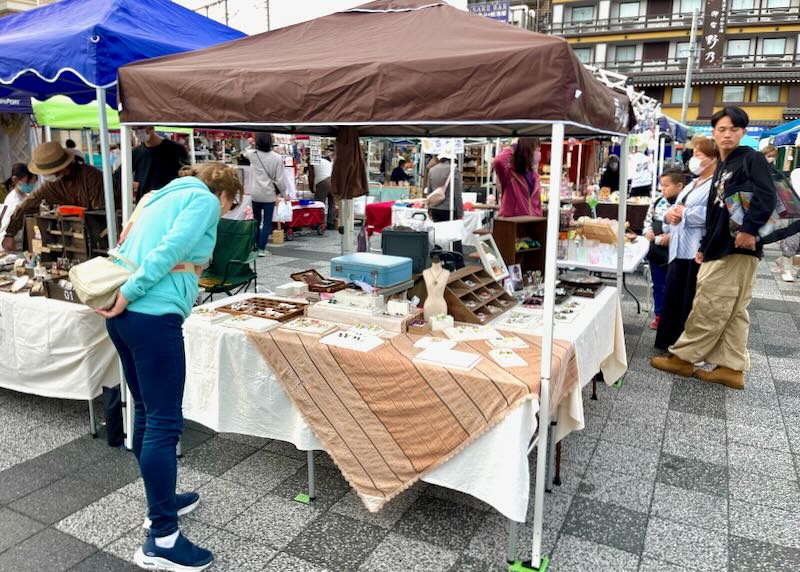
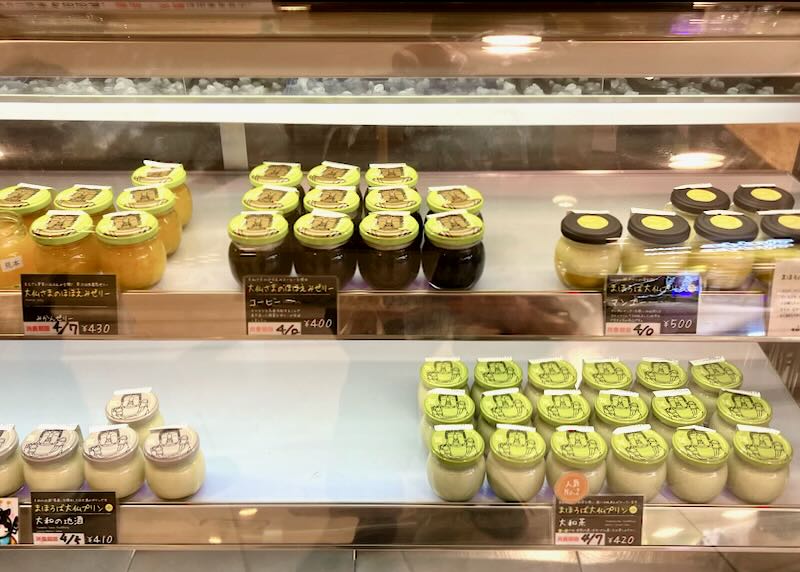

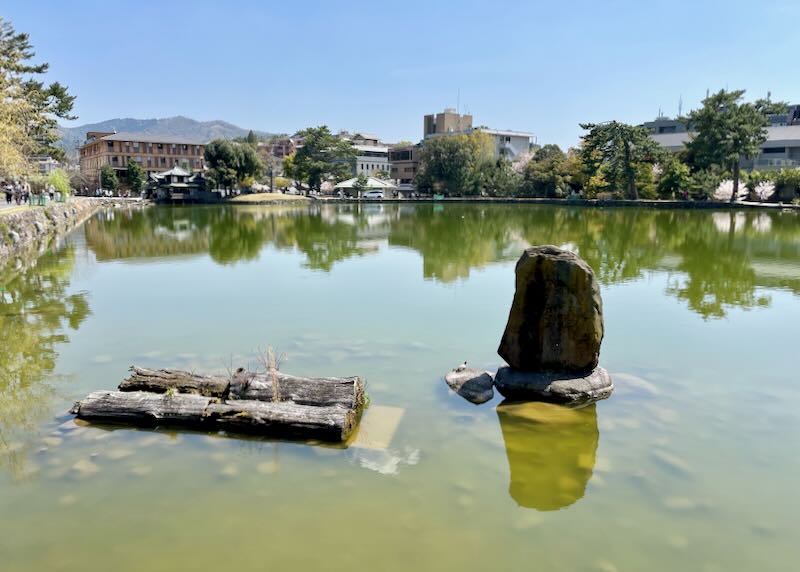
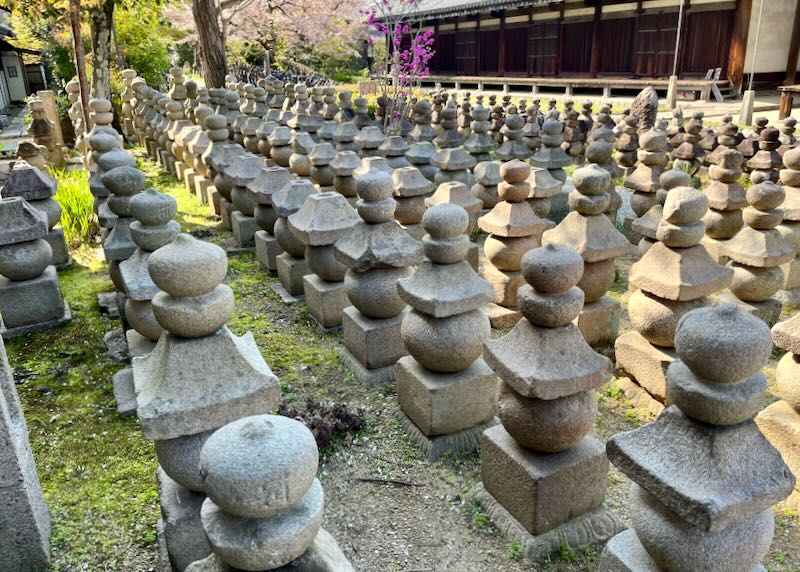
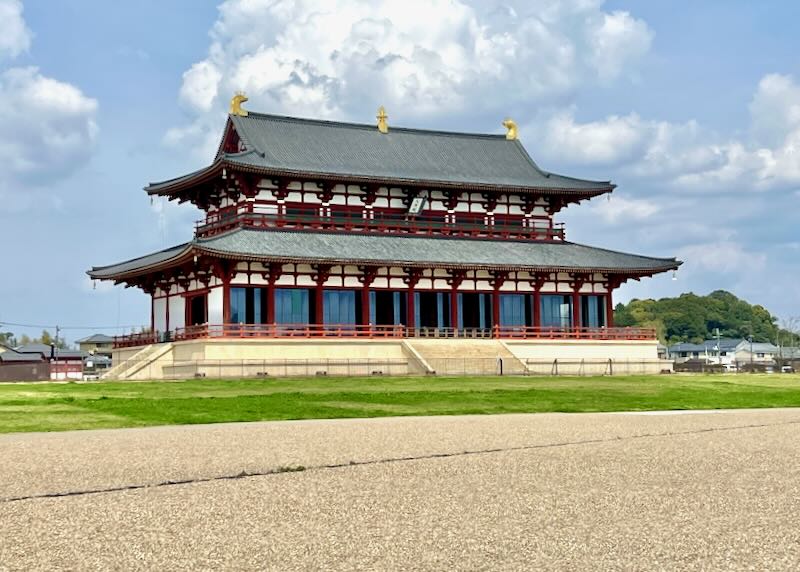
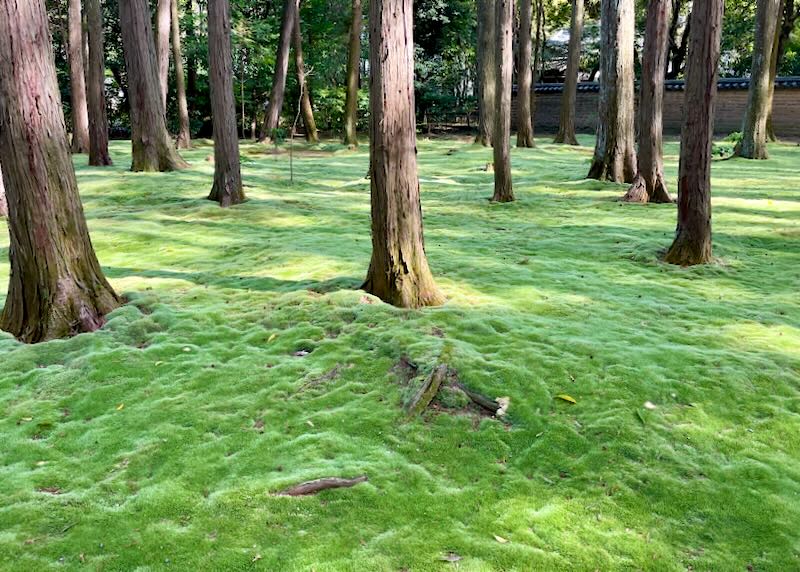
About Santorini Dave